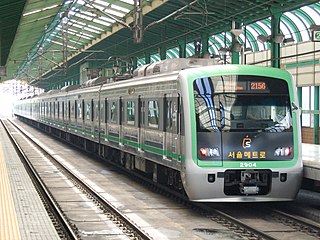
The Seoul Metropolitan Subway is a metropolitan railway system consisting of 22 rapid transit, light metro, commuter rail and people mover lines located in northwest South Korea. The system serves most of the Seoul Metropolitan Area including the Incheon metropolis and satellite cities in Gyeonggi province. Some regional lines in the network stretch out to rural areas in northern Chungnam province and western Gangwon province that lie over 100 km away from the capital as well as Suwon.

The South Manchuria Railway, officially South Manchuria Railway Company, or 滿鐵 for short, was a large National Policy Company of Japan whose primary function was the operation of railways on the Dalian–Fengtian (Mukden)–Changchun corridor in northeastern China, as well as on several branch lines. However, it was also involved in nearly every aspect of the economic, cultural and political life of Manchuria, from power generation to agricultural research, for which reason it was often referred to as "Japan's East India Company in China".
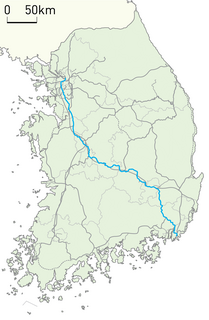
The Gyeongbu Line (Gyeongbuseon) is the most important railway line in South Korea and one of the oldest ones in the country. Gyeongbu line was constructed in 1905, connecting Seoul with Busan, via Suwon, Daejeon, and Daegu. The Gyeongbu Line is by far the most heavily travelled rail line in South Korea.

The Gyeongin Line (Gyeonginseon) is a railway mainline in South Korea, currently connecting Guro Station in Seoul and Incheon. Commuter services along the line through operates into Seoul Subway Line 1.

Amagasaki is an industrial city located in Hyōgo Prefecture, Japan. The city was founded on April 1, 1916. Its population is around 460,000, below its peak of over 554,000 in 1971.
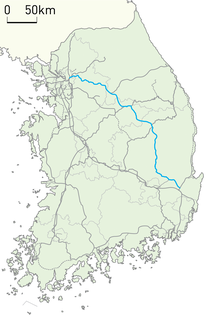
The Jungang line is a railway line connecting Cheongnyangni in Seoul to Gyeongju in South Korea, traversing central South Korea from the northwest to the southeast. It also referred to the rail line of the Seoul Metropolitan Subway from Yongsan station to Yongmun station.
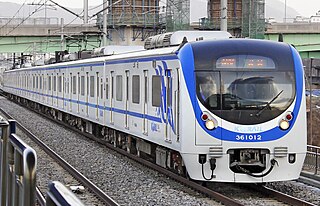
The Gyeongchun Line is a regional rail line between Seoul and Chuncheon operated by Korail. The name of the line is derived from Gyeong and Chuncheon. The line was reconstructed in a new alignment in its entirety in the 2000s. Rail service operates between Sangbong Station on the Jungang Line in eastern Seoul and Chuncheon Station as part of the Seoul Metropolitan Subway system since December 21, 2010. A class of regional rail service named ITX-Cheongchun began operations on February 28, 2012, linking Chuncheon to Cheongnyangni and Yongsan Stations.

The Gyeongwon Line is a railway line serving northeastern Gyeonggi Province in South Korea. The line is operated by Korail. The name of the line came from Gyeongseong (Seoul) and Wonsan, the original terminus of the line, in what is now North Korea.

The Janghang Line is a railway line serving South Chungcheong Province in South Korea. The line connects Cheonan to the railway junction city of Iksan. The Janghang Line is served by frequent Saemaul-ho and Mugunghwa-ho passenger train services between Seoul and Iksan. There is also a link from Asan Station to the KTX network at Cheonan Asan Station.

The Gyeongui Line is a railway line between Seoul and Dorasan Station in Paju. Korail operates the Seoul Metropolitan Subway service between Seoul Station and Munsan Station.

Tsuruhashi Station is a railway station complex in the Tsuruhashi district of Ikuno-ku and Tennoji-ku, Osaka, Japan. It is served by the JR West Osaka Loop Line, the Kintetsu Nara Line, and the Osaka Metro Sennichimae Line.

Yongsan station is a major railway station in Seoul, South Korea. It is located in Yongsan District, and adjoins the Yongsan Electronics Market. The station is the terminus for high-speed and long-distance trains on a number of railway lines, including most trains on the Honam Line, its high-speed counterpart, and all trains on the Janghang and Jeolla Lines.

Dongdaegu Station, meaning "East Daegu Station", is a railway station in Daegu, South Korea. It is on the national high-speed KTX railway network, 282 km (175 mi) south of Seoul Station.

Suwon Station is a railway station in the city of Suwon, South Korea. The station was completely redeveloped in 2002 and 2003, and is now integrated with the Aekyung Shopping Mall. This station serves the national Gyeongbu Line and Line 1 of the Seoul subway, which runs services from Soyosan Station to the north to Sinchang to the south.

Dorasan Station is a railway station situated on the Gyeongui Line, which used to connect North Korea and South Korea and has since been restored. Dorasan Station is located approximately 650 meters from the southern boundary of the Korean Demilitarized Zone and is currently the northern terminus of Korail's Gyeongui Line, which is served by Tonggeun commuter trains. North of here the former Gyeongui Line continues as the Korean State Railway's P'yŏngbu Line, but this connection is not in regular service. The current purpose of the station is largely symbolic of the hope for eventual Korean reunification.

Daejeon Metro is the rapid transit system of Daejeon, South Korea, operated by the Daejeon Metropolitan Express Transit Corporation. The single-line subway network first opened in 2006 with 12 stations. The line was expanded in 2007 and it now consists of one line, 22 operating stations, and 22.6 kilometres (14.0 mi) of route.

Daejeon Station is on South Korea's high-speed KTX railway network, 166.6 km south of Seoul Station.

Munsan Station is a railway station on the Gyeongui Line, and the northern terminus of the Gyeongui–Jungang commuter rail line. It is notable for being the closest station on the Seoul Metropolitan Subway to the border with North Korea that is open for passenger service, only a few kilometers away. As a regular railway station it is an interim stop between Dorasan Station in the Demilitarised Zone and Seoul Station.

The Suseo–Pyeongtaek high-speed railway or Super Rapid Train (SRT) is a high-speed railway from Suseo in southeast Seoul to a junction with the existing Gyeongbu high-speed railway in South Korea. The line is part of SR's Korea Train Express (KTX) system, and provides an alternative Seoul terminus for Gyeongbu KTX and Honam KTX services to Mokpo and Busan at the Seoul end.
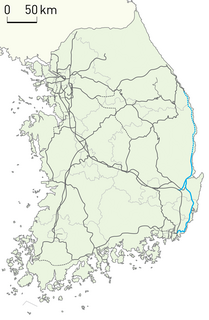
The Donghae Line is a railway line connecting Moryang Station/Busanjin Station to Pohang Station in South Korea; the literal meaning of its name, "east sea line" reflects its position along the nation's east coast. It merged Donghae Nambu Line on December 30, 2016, and will merge Donghae Bukbu Line.






















